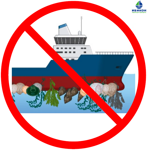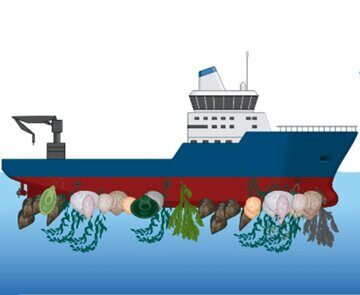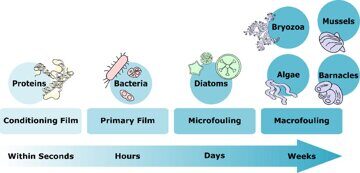 Biofouling Management Plan (BFMP) 29.10.2023 17:56
Biofouling Management Plan (BFMP) 29.10.2023 17:56IMO’s Marine Environmental Protection Committee (MEPC) adopted revised 2023 Guidelines for the control and management of ships' biofouling to minimize the transfer of invasive aquatic species (IMO Resolution MEPC.378(80)).
Biofouling is the accumulation of aquatic organisms such as microorganisms, plants and animals on surfaces and structures immersed in or exposed to the aquatic environment. Biofouling can include pathogens. For microfouling and macrofouling, see definitions below.
Prediction of risk of introducing invasive species is complex, hence these Guidelines have the intention to minimize the accumulation of biofouling on ships. Biofouling may include invasive species while a clean hull and niche areas significantly reduce this risk. Studies have shown that the biofouling process begins within the first few hours of a ship's immersion in water:
The biofouling pressure on a specific ship is influenced by a range of factors, starting with design and construction of the ship hull and niche areas, followed by operating profile of the ship and maintenance history. These Guidelines describe recommended biofouling management practices, as illustrated in figure below:
Biofouling management practices may also improve a ship's hydrodynamic performance and can be effective at enhancing energy efficiency and reducing air emissions from ships.
The need for inspection and biofouling management may depend on the use of AFS, cleaning regime, and the overall risk of biofouling on the hull and in niche areas. By conducting ship-specific monitoring of risk parameters, identifying potential higher risk for biofouling, an optimized regime for biofouling management can be determined. Cleaning is an important measure to remove biofouling from the hull and niche areas but, when conducted in-water, it poses a risk of releasing invasive aquatic species into the water.
An example of a flow chart for visualizing biofouling management risk profile and monitoring of parameters is shown in figure below:
Hull with typical niche areas susceptible to biofouling are indicated in figure below:
It is recommended that every ship have a ship-specific Biofouling Management Plan (BFMP) under the responsibility of shipowners, ship operators and shipmasters. A BFMP may require information from ship designers, shipbuilders, shipowners, AFC and MGPS manufacturers, recognized organizations and suppliers.
The overall record-keeping of ship-specific biofouling management activities in a Biofouling Record Book (BFRB) is the responsibility of shipowners, ship operators and/or shipmasters. The ship-specific BFRB should include information on biofouling management actions with input from AFS manufacturers and suppliers, ship cleaning and maintenance operators, inspection organizations, and ship repair and dry-docking facilities when relevant.
Within the framework of the existing Safety Management System (SMS), IBICON offers you
services for the development of the following documents:
- Biofouling Management Plan (BFMP)
- Biofouling Record Book (BFRB)






